Introduction
Cash flow forecasting is a crucial aspect of financial planning for businesses, providing a forward-looking view of their financial health and operational efficiency. By accurately predicting cash inflows and outflows, companies can effectively manage their resources, handle working capital, and avoid liquidity pitfalls. The distinction between cash flow and profit is also essential, as cash flow represents the actual movement of money in and out of the business, critical for covering expenses, strategic investments, and funding growth.
Without sufficient cash, even the most profitable businesses can face dire consequences. In this article, we will explore the importance of cash flow forecasting, better financial management, improved decision-making, the early identification of cash flow issues, the components of a cash flow forecasting model, the role of historical data, sales and expense forecasting, accounts receivable and payable, other cash inflows and outflows, creating a cash flow forecasting model, and best practices for effective cash flow forecasting. By mastering cash flow forecasting, businesses can ensure financial stability, make informed decisions, and navigate the complexities of today's dynamic financial landscape.
Why Cash Flow Forecasting is Important
Mastering cash flow is a cornerstone of successful financial planning, as it provides a comprehensive view of the financial health of a business. Cash flow forecasting, specifically, is a critical component of this mastery, offering a forward-looking gauge of financial stability and operational efficiency.
Mark Valentino, head of Business Banking at Citizens, emphasizes the importance of cash flow forecasting, stating, "We work closely with our business customers to identify critical needs. Then, we provide digital tools that offer an exceptional customer experience and empower them to make confident financial decisions."
Cash flow forecasting isn't just about tracking the flow of money; it's about strategically managing it to prevent cash shortages that can stunt growth or, worse, lead to business failure. A survey of 600 small and mid-size business principals by Citizens uncovered that respondents who consolidated their cash flow applications enjoyed increased profitability (44%), heightened productivity (43%), and reduced costs (42%).
Understanding the distinction between cash flow and profit is also fundamental. While profit measures overall financial gain, cash flow represents the actual movement of cash in and out of the business—key to covering expenses, investing strategically, and funding growth. In fact, without sufficient cash, even the most profitable businesses can face dire consequences, underscoring the importance of accurate cash flow forecasting.
By leveraging insights from cash flow forecasting, businesses can ensure liquidity, make informed investment decisions, and maintain a competitive edge—a necessity in today's dynamic financial landscape.
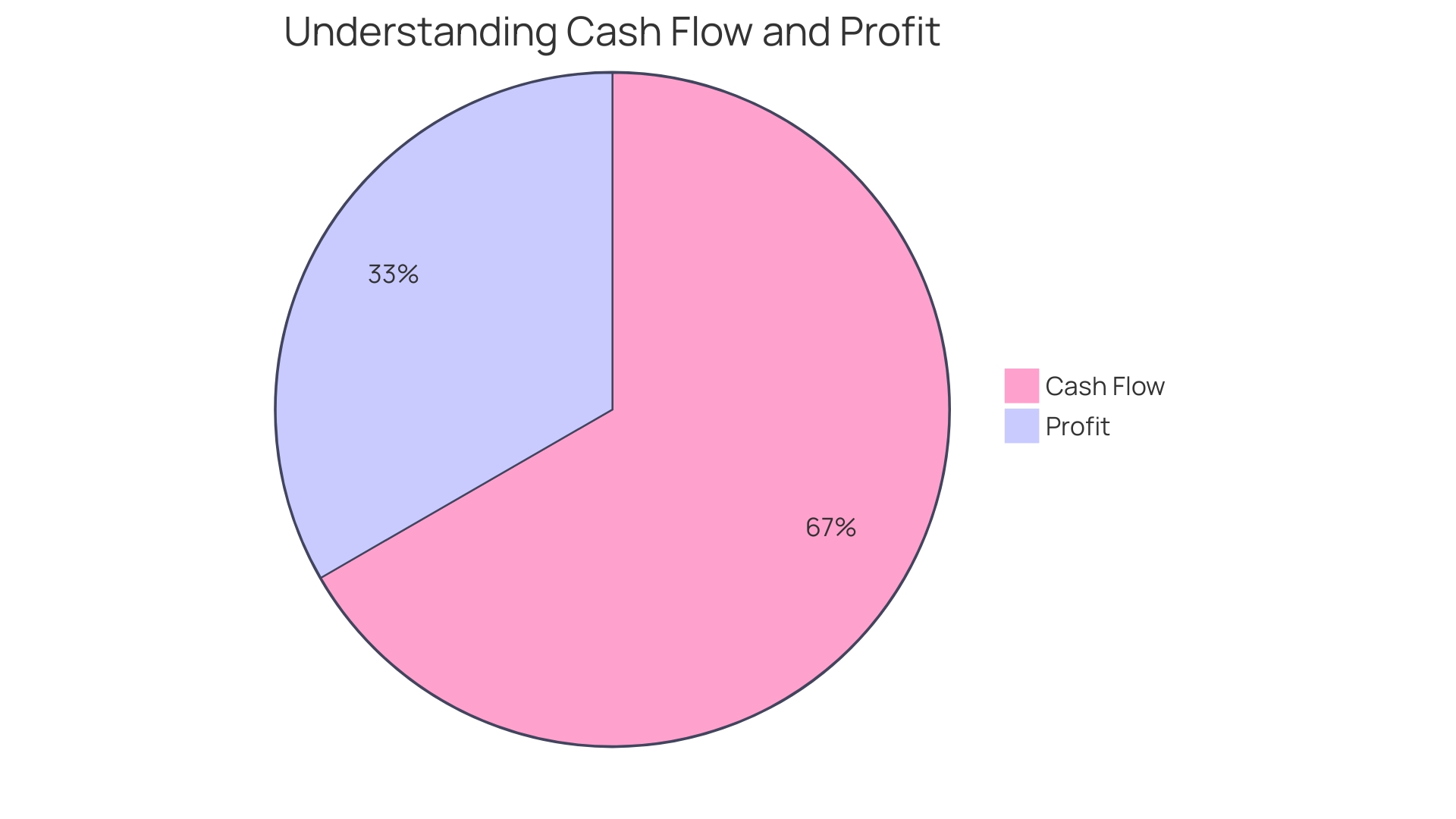
Better Financial Management
Forecasting cash flow is critical for business vitality, as it provides a lucid snapshot of financial health and assists in future planning. Through precise predictions of cash receipts and disbursements, companies can judiciously manage resources, handle working capital, and sidestep potential liquidity pitfalls. The significance of cash flow can't be overstated—it's the lifeblood that facilitates business operations, enabling strategic investments and growth.
Conversely, a cash crunch can immobilize even the most promising enterprises, leading to dire outcomes. Businesses, especially those in e-commerce or consulting, where transactions and client payments are pivotal, must diligently track cash flow to ensure steady operations and avoid the debilitating effects of cash deficits. This understanding is not just theoretical; statistics reveal that data-driven decision-making, which includes meticulous cash flow analysis, is becoming integral for organizations seeking competitive advantage.
Moreover, experts like Dr. Sharon H. Porter emphasize the importance of comprehensively reviewing financial statements to avoid common cash flow management errors. By maintaining a robust cash flow management strategy, businesses position themselves for sustained profitability and long-term success.
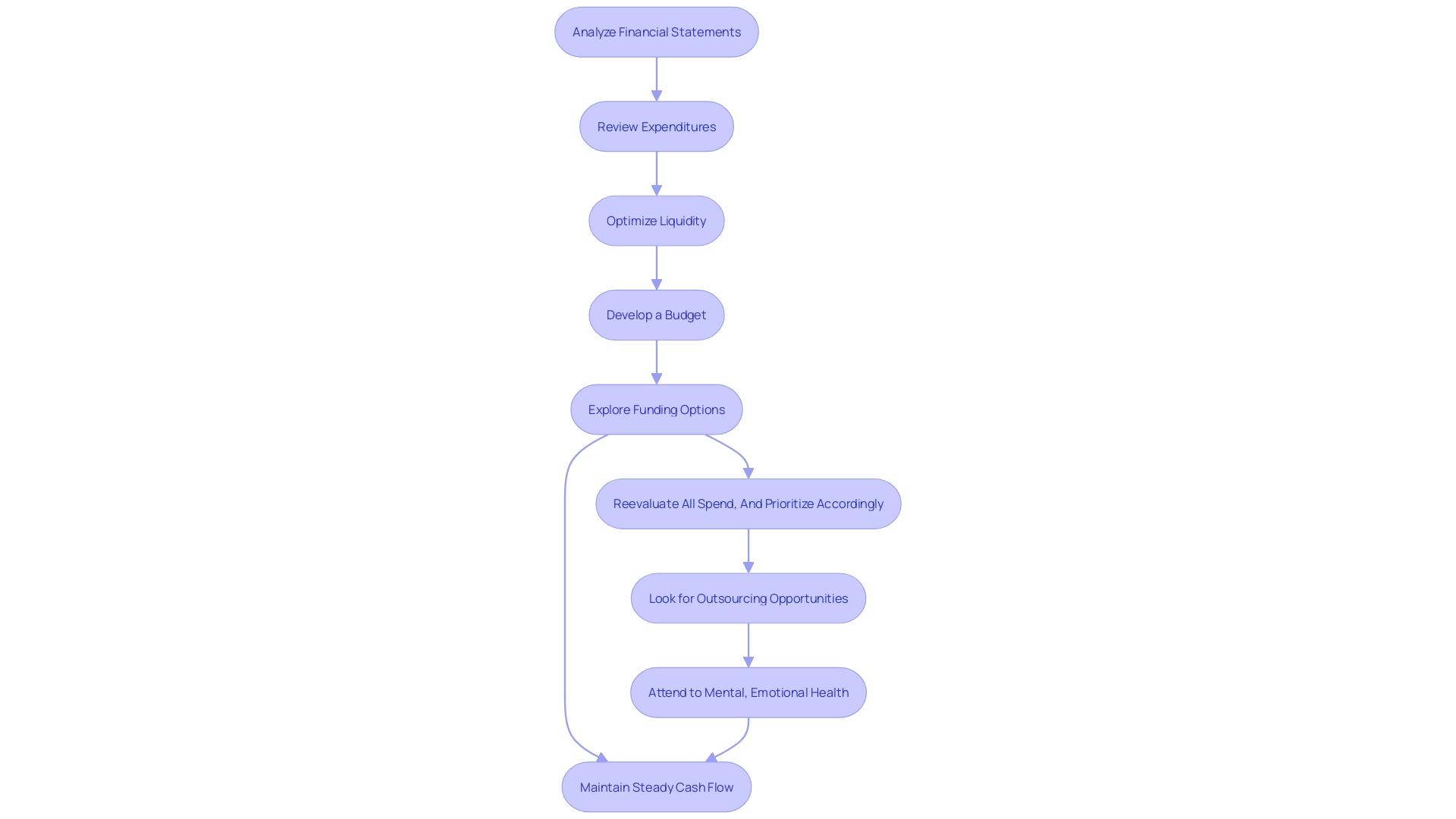
Improved Decision-Making
Grasping the reins of cash flow is not merely about tracking numbers—it's a strategic imperative for business vitality and expansion. Sophisticated forecasting methods, like those applied by Citizens Financial Group with its substantial $220.4 billion in assets, offer a clear view of fiscal health, enabling strategic decisions around investments and growth initiatives. The use of Monte Carlo simulations, for instance, is a testament to the advanced strategies organizations are utilizing to predict financial outcomes and plan releases in alignment with critical infrastructure needs.
Cash flow's importance is echoed by statistics revealing that 40% of CFOs lack full confidence in the accuracy of their financial data, underscoring the necessity for improved visibility. This is especially pressing as nearly 78% of finance leaders harbor concerns about potential global financial crises, demonstrating the critical role of cash flow management in navigating uncertainties.
Moreover, AI's rising influence in the financial sector is notable, with 68% of finance leaders open to AI-derived recommendations, and a significant portion recognizing its capacity to involve non-finance departments in planning without specialized training. The embrace of AI signifies a shift towards more inclusive and efficient financial planning, reflecting a broader trend of democratizing data access and enhancing real-time analysis capabilities.
In essence, effective cash flow management is paramount to a company's success, as it provides the liquidity needed for operational stability and strategic maneuvers. It's the lifeblood that keeps businesses thriving, and mastering it is crucial in a landscape where cash shortages can precipitate the downfall of even the most promising ventures.

Early Identification of Cash Flow Issues
Mastering cash flow forecasting is akin to a navigator charting a course for smooth sailing. It's a strategic tool that enables businesses to anticipate and navigate financial turbulence by meticulously tracking cash inflows and outflows. Such vigilance over financial currents empowers organizations to strategically circumvent liquidity crunches and cash shortfalls before they escalate into storms.
Utilizing cash flow forecasting, a company can leverage its understanding of future revenue streams, informed by factors such as projected store expansions or investments, to solidify its financial footing. As demonstrated in Bain's research, the rarity of unicorns—startups valued at over $1 billion—achieving cash-positive operations underscores the value of foresight in financial planning.
The significance of cash flow management is echoed by the wisdom of financial experts who liken it to the lifeblood of a business. It's not simply about survival; it's about the ability to invest, grow, and outlive competitors. This is clearly illustrated by the stark reality that, without a proactive approach to managing cash flow, even the most promising ventures risk joining the graveyard of failed businesses.
On the frontlines of financial management, cash flow statements serve as an essential barometer, delineating cash movements across operating activities, investments, and financing. These statements are a testament to a business's vitality, revealing the health of its core operations through the lens of cash transactions.
In today's fast-paced business environment, where a company's ability to maintain liquidity is as crucial as its profitability, the adept use of cash flow forecasting stands as a beacon of strategic financial stewardship. It enables businesses to remain agile, ensuring that cash is always at the ready to fuel growth, cover essential costs, and propel the company toward a prosperous future.

Components of a Cash Flow Forecasting Model
Crafting an effective cash flow forecasting model is a critical exercise for any business, as it provides a forward-looking view of cash inflows and outflows. A robust model is composed of several key elements that work in concert to offer a comprehensive analysis of the organization's liquidity. Let's dissect the core components of such a model:
-
Operating Activities: The lifeline of any business, operating activities include all the cash transactions related to the day-to-day functioning. This encompasses cash inflows from sales and outflows for operational expenses. To adjust for non-cash transactions, elements like depreciation are factored in, alongside variations in working capital accounts such as receivables and payables.
-
Investing and Financing Activities: Beyond daily operations, a business engages in investments and financing that impact cash flow. This includes cash spent on acquiring assets and cash received from loans or equity financing. For instance, a company like Citizens Financial Group, with substantial assets, would meticulously track these activities to manage their cash flow effectively.
-
Forecasting Future Cash Flows: A forward-looking component of the cash flow model involves projecting expected cash flows. This includes estimating future sales, expenses, and investment returns. The Discounted Cash Flow (DCF) method is often employed here, which accounts for the time value of money, emphasizing that the current value of cash is greater than the same amount in the future.
-
Financial Analysis and Revision: Financial analysts play a pivotal role in analyzing and revising cash flow forecasts by scrutinizing financial statements and market trends. Their expertise is critical in forecasting future financial performance and updating the model as business conditions evolve. As such, their insights help businesses stay agile in managing their finances.
-
Pulse on Current Economic Trends: Staying updated with economic news, such as changes in the national living wage or shifts in retirement income statistics, can influence forecasting models. These external factors can impact consumer spending and savings behavior, ultimately affecting a business's cash flow.
Incorporating these elements into a cash flow forecasting model equips businesses with the nuanced understanding needed to maintain a healthy cash balance and navigate the complexities of financial management.

Historical Data
Crafting a precise cash flow forecast hinges on a meticulous examination of historical financial data. Such an analysis sheds light on previous cash flow tendencies, including seasonal variations and recurring financial cycles, which are invaluable for forecasting. A deep dive into the company's cash flow history enables businesses to anticipate future financial needs with greater accuracy, thus optimizing operations.
For instance, understanding the movement of cash through the company during peak and off-peak seasons can help in adjusting budget allocations to ensure liquidity throughout the year. It's also crucial to consider how macroeconomic factors and market shifts can influence cash flow, adapting strategies in response to these changes to maintain a competitive edge and sustainable growth.
Moreover, incorporating insights from various industry sectors and economic indicators can enhance the precision of cash flow projections. Financial forecasting is not just about looking at past trends but also about integrating comprehensive market analysis and financial intelligence to navigate through the ever-evolving business landscape effectively.
Sales Forecast
A robust sales forecast is the linchpin of effective cash flow management in any business, particularly those whose lifeline is sales revenue. This complex prediction activity transcends mere guesswork; it entails a nuanced analysis of market trends, customer behaviors, and a myriad of other essential factors. Ensuring the accuracy of these predictions is crucial for anticipating cash inflows and thus, solidifying the financial planning process.
Historically, sales forecasts have leaned heavily on past data, but this approach is often insufficient for navigating today's rapidly changing consumer landscapes. External factors like macroeconomic trends, social dynamics, technological progress, geopolitical events, and even pandemics have significant impacts that historical data alone can't predict. Moreover, as consumer preferences evolve—shaped by cultural shifts, digital transformation, and sustainability concerns—sales forecasting models must adapt to capture this diversity and dynamism.
Manufacturing enterprises, distinct from traditional retail markets, grapple with unique challenges that affect their sales forecasts. Stock management to match customer demand, addressing seasonality, and responding to unexpected demands are all part of the equation. These enterprises must consider not only the internal factors such as pricing, promotions, and market share but also external pressures that could affect sales volumes and profitability.
For example, the automotive industry is currently experiencing significant changes, with an expected increase in retail inventory leading to price moderation and potentially affecting sales in 2024. Similarly, the rise in battery electric vehicle (BEV) sales, surpassing 1 million units in a year for the first time, indicates a shift in consumer preferences that must be factored into forecasting models.
In essence, the ability to forecast sales accurately is a crucial aspect of cash flow management. It demands a forward-thinking approach that incorporates both internal business metrics and external environmental factors to remain relevant and reliable. When done effectively, it's a powerful tool for ensuring a business's financial health and long-term sustainability.
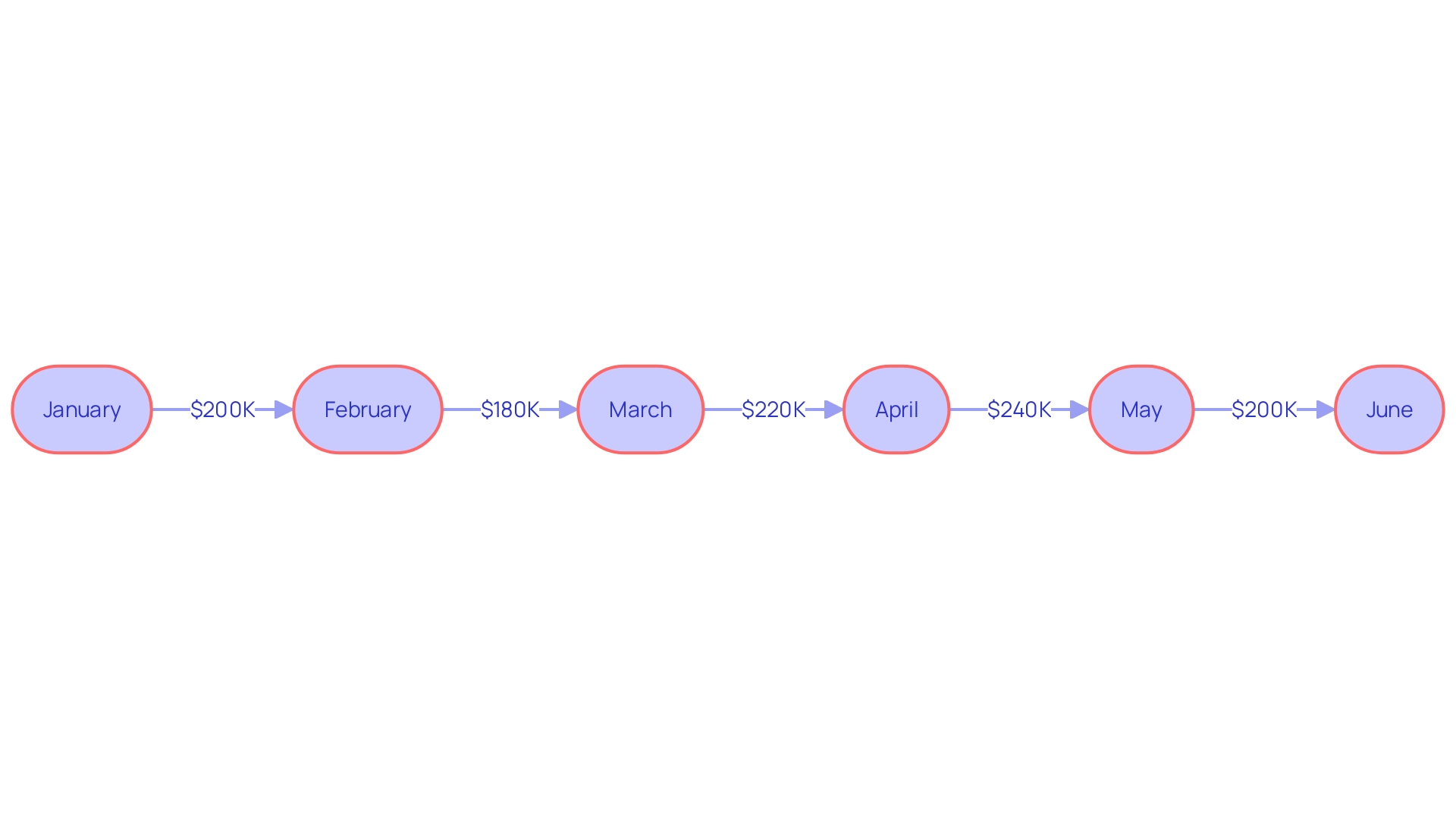
Expense Forecast
Crafting a financial forecast is akin to charting a course for a ship's journey, requiring a captain to anticipate all possible expenditures to maintain smooth sailing. Fixed costs, such as rent and salaries, and variable costs, like materials and utilities, form part of the financial seascape. Overhead expenses also loom large, as they can drastically affect the course of the business.
A comprehensive financial forecast accounts for these costs, predicting cash outflows with precision and care.
To lay the groundwork for accurate expense forecasting, it's essential to delve into the company's financial history. This involves assembling at least three years of sales records, expense reports, and financial statements to identify seasonal patterns, long-term trends, and anomalies. For newer ventures, whatever data is available will serve as a starting point.
This historical analysis is not just reflective but instructive, shedding light on patterns and trajectories that inform future financial planning.
A financial forecast is not complete without a thorough understanding of revenue streams. It's imperative to dissect income into its various channels—be it product sales, service fees, or recurring subscriptions—to paint a clear picture of financial inflows. This breakdown is a strategic exercise, guiding the prediction of future income with greater precision.
Furthermore, as underscored by a travel and expense management software expert with over five years of dissecting financial processes, pinpointing the essence of effective expense policies is crucial. Such policies offer a blueprint for compliance and operational efficiency, particularly vital for small businesses aiming to optimize resources and maintain financial health. They serve as a guide for adhering to tax laws and regulations, mitigating the risk of penalties and noncompliance.
By standardizing expense approval and reimbursement procedures, businesses can allocate time and resources to more strategic pursuits.
In essence, expense forecasting is a dynamic and vital process for any business, allowing for proactive management of financial resources, ensuring that the vessel of commerce navigates the waters of the market with both foresight and agility.
Accounts Receivable and Payable
Mastering the ebbs and flows of cash within your organization is pivotal for maintaining financial health. Comprehending the movement of cash in and out, through accounts receivable and payable, is more than a mere balance sheet exercise; it's about predicting and orchestrating the timing of cash transactions. Delving into the payment and credit terms along with the collection periods gives you a clear forecast of when money will be entering and leaving the business.
This is akin to having a financial roadmap, enabling you to navigate through the commercial landscape with the foresight to avoid cash shortages that can be detrimental to any enterprise. As such, your strategic financial planning must include a vigilant analysis of these components to maintain a robust cash flow, ensuring your business remains vibrant and solvent.
Other Cash Inflows and Outflows
To maintain a robust financial strategy, it's crucial to account for every facet of your business's cash flow. Beyond the familiar territories of sales and expenditures, there are other financial activities that can significantly impact your company's liquidity. Investment decisions, the servicing of loans, the receipt of interest income and dividends, and tax payments are all elements that can alter the cash flow landscape.
For instance, the rise of eCommerce has demonstrated how low startup costs and direct access to a global market can lead to smooth transactions and significant cash inflows. Simultaneously, the consulting sector has shown us the benefits of flexible rate setting and the potential for steady, ongoing client payments.
A comprehensive cash flow forecast must, therefore, encapsulate these diverse sources of cash. Such a holistic approach will not only provide a clearer picture of your organization's cash position but also offer insights into potential cash shortages – a critical aspect that, if ignored, can lead to the downfall of even the most promising ventures.
Understanding the intricate balance between cash flow and profit is paramount. While profit maximization is a common goal, for a growing business, sometimes prioritizing investments that may not yield immediate profits can be strategic for long-term value creation. This nuanced view of financial performance underlines the importance of a thorough and inclusive cash flow forecast.
In light of this, businesses are encouraged to continuously reevaluate their financial strategies, ensuring their spending and investment decisions align with their overarching goals of sustainability and growth. Companies that master this balance can navigate the complex financial landscape more successfully, bolstering their prospects for long-term profitability and value maximization.
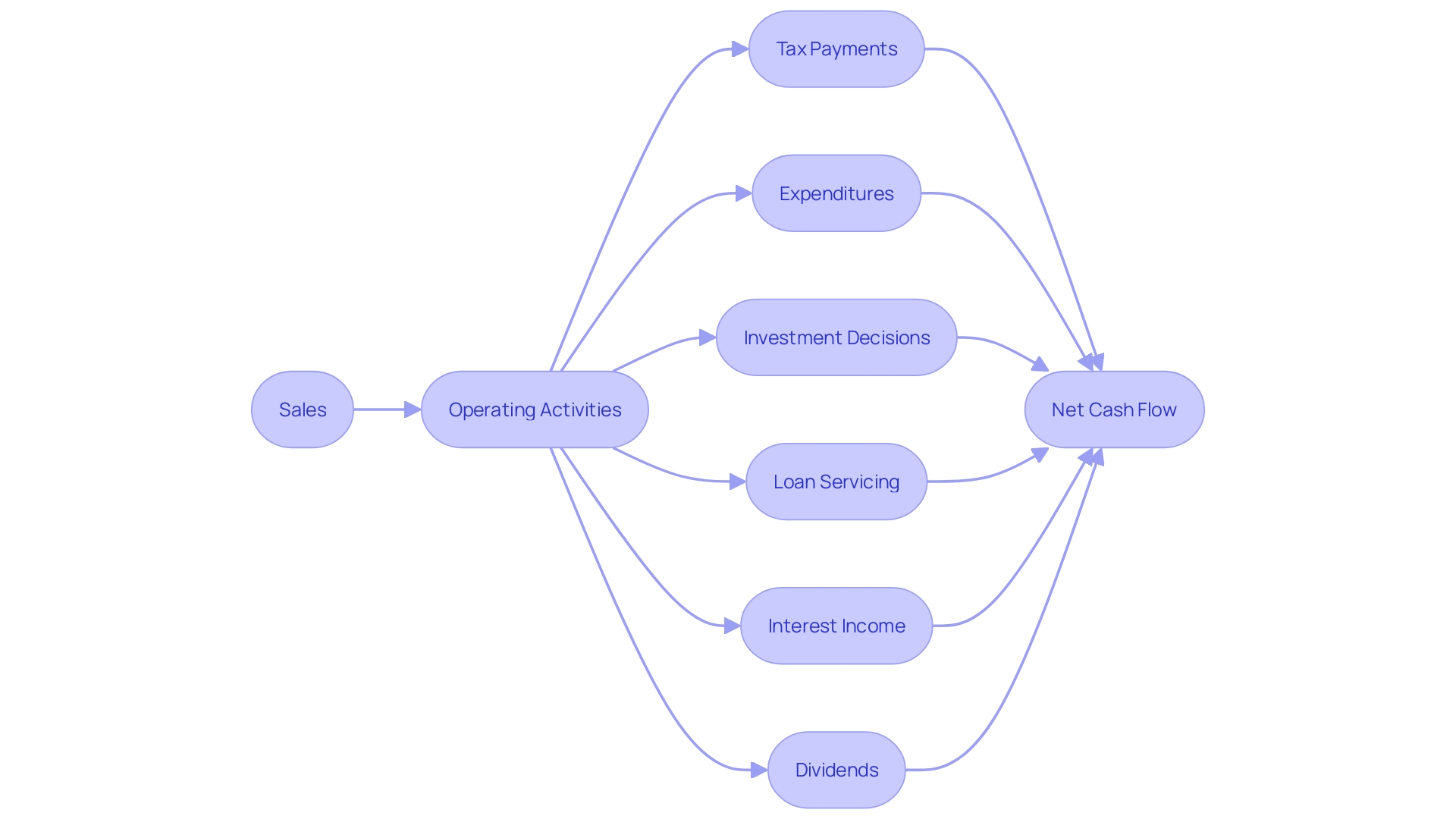
Creating a Cash Flow Forecasting Model
Building a robust cash flow forecasting model is an iterative process that provides a clear picture of your business's financial health. It starts by understanding the intricacies of your business model, whether you're running a direct-to-consumer operation or managing a complex marketplace. For instance, Citizens Financial Group, with $220.4 billion in assets, maintains a detailed approach to financial services, offering tailored solutions that demonstrate the importance of customized forecasting.
To begin, it's critical to identify the financial forecast's purpose and compile all necessary financial statements and data. Choosing the appropriate time frame and forecasting method is next, whether it's a short-term prediction or a long-term strategy. Remember, a financial model is a living document, always open to adjustments with new data.
One commonly utilized framework is the Three Statement Model, which integrates income statements, cash flow, and balance sheets. Meanwhile, for small businesses looking to stay agile, models like the Discounted Cash Flow Model can help predict future cash flows and assess business value.
It's essential to recognize the difference between forecasting and budgeting; forecasting predicts future performance based on historical data, while budgeting sets financial targets. Both are integral to financial planning, as they aid in setting budgets and tracking progress.
As Daniel J. Boorstin once suggested, writing down your financial predictions organizes your thoughts and provides a record of beliefs at a specific time. Such documentation is crucial for inviting valuable feedback and ensuring that your financial strategies remain aligned with your business goals.
Ultimately, a successful cash flow forecast is about more than just crunching numbers; it's about creating a financial narrative for your business that helps you steer towards profitability and long-term value maximization. With the right model in place, you can confidently navigate your business through the ebb and flow of market demands and financial challenges.
Step 1: Gather Historical Data
To master the intricacies of cash flow forecasting, one must begin with a meticulous examination of historical cash flow data. This foundational analysis is not just a routine step; it's an insightful dive into the past to uncover trends and inform future projections. By thoroughly understanding the ebb and flow of past cash movements, one can gain a deeper comprehension of an organization's financial rhythms, much like economists use indicators such as GDP and consumer spending to analyze and predict economic cycles.
Experts emphasize the importance of recognizing the distinction between cash flow and profit, understanding that the vitality of a business hinges on the steady movement of cash in and out. A robust analysis of historical cash data helps to ensure that the business remains equipped to meet its obligations and steer clear of any potential cash shortages that could imperil its operations. Embracing this analytical approach, bolstered by the latest advancements in machine learning and comprehensive financial data APIs, enhances the precision of cash flow forecasting, making it an indispensable tool for sustaining a business's financial health.
Step 2: Determine the Forecasting Period
When it comes to crafting a cash flow forecast, a one-size-fits-all approach doesn't exist. The frequency of your forecast—be it monthly, quarterly, or annually—should hinge on the unique demands of your business and the precision you aspire to achieve. Taking a leaf from the playbook of Auchan Ukraine's experience, where they managed to harness daily forecasts for a multitude of food products across 22 hypermarkets, it's clear that granularity can pay dividends.
They were able to project demand up to 55 days in advance, fine-tuning their predictions to the store and SKU level and reducing stockouts and overstock by a notable 18% in a single year.
By laying the groundwork with solid historical data, as emphasized by the significance of compiling at least three years of financial activities, you position your forecast on a bedrock of reality, accounting for seasonal shifts and long-term trends alike. This historical data panorama should encompass sales, operating costs, and profit margins, which facilitates a robust predictive model that parallels the strategic foresight displayed by major players in the retail sector.
Furthermore, understanding the difference between cash flow and profit is paramount. As highlighted by the cautionary advice that 'cash is queen,' it's not merely about the profitable facade of your enterprise but also about the underlying cash movements that sustain its vitality. Comprehending and anticipating the ebb and flow of your business's cash is critical in averting any potential shortages that could abruptly end its success story.
Lastly, the statement of cash flows is not merely an accounting formality but a vital tool for investors to assess a company's financial health and prospects. As such, the same meticulousness applied to other financial statements should be employed here, ensuring that your cash flow statements reflect the real-time status of your business and align with investor expectations for accuracy and transparency.

Step 3: Identify Key Variables
When crafting your cash flow forecast, it's essential to examine the primary elements that influence cash movement within your business. These elements include your sales volume, incurred expenses, the timing and amount of accounts receivable, and the obligations of accounts payable. Sales are the lifeblood of any business and can significantly impact cash flow.
An increase in sales generally leads to a boost in cash flow, provided that receivables are collected in a timely manner. Conversely, expenses, both fixed and variable, can drain cash reserves if not carefully managed. Monitoring accounts receivable is crucial since delayed collections can create cash flow bottlenecks, while effectively managing accounts payable can help maintain a healthy cash reserve.
For example, an eCommerce store benefits from low overhead costs and swift online transactions, which can lead to a positive cash flow situation. A consulting business, with its potential for ongoing client engagements and the ability to set its own rates, can also establish a predictable and positive cash flow. Both types of businesses showcase the importance of understanding cash flow dynamics to avoid the devastating consequences of cash shortages and to ensure long-term profitability.
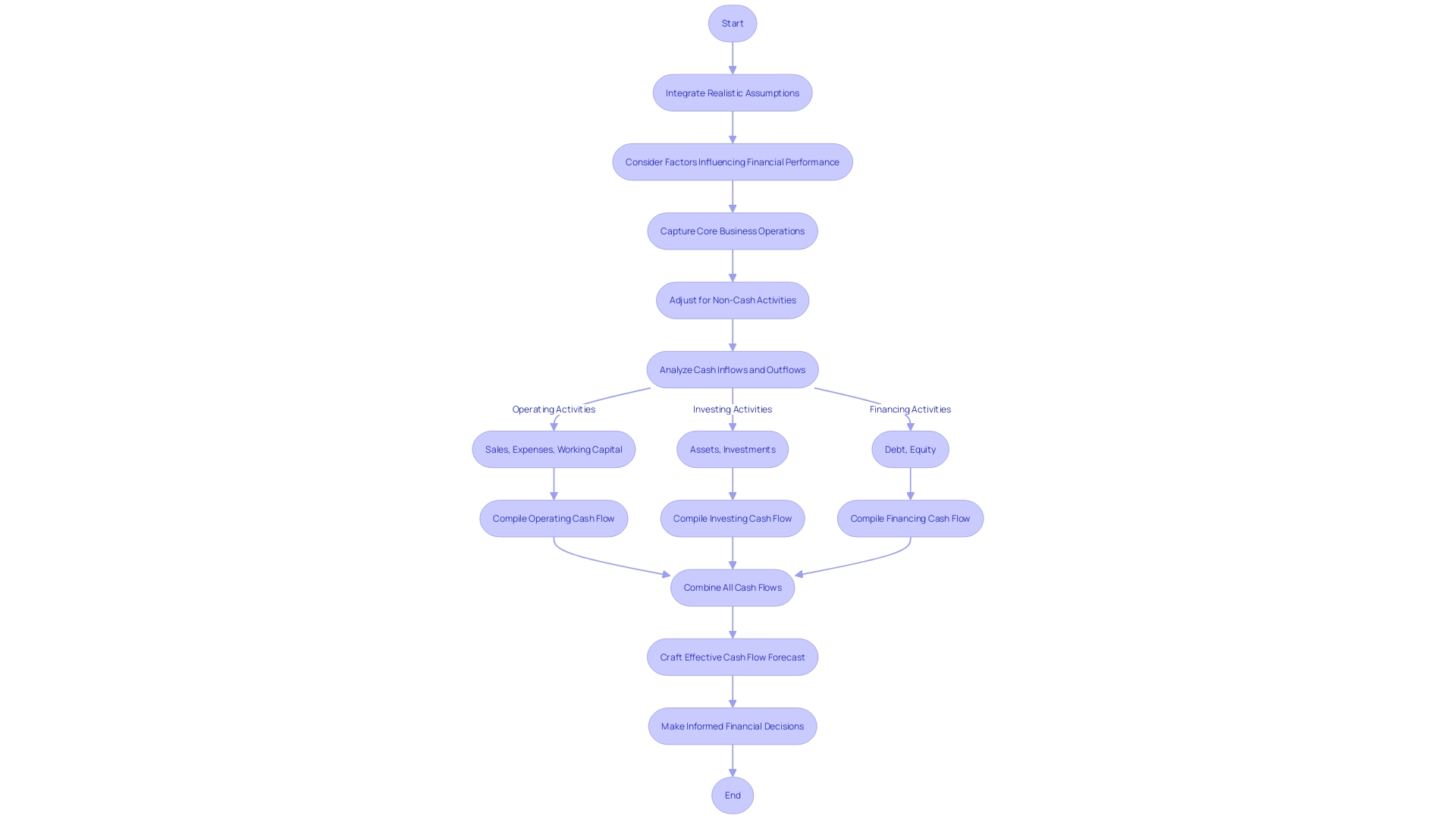
Step 4: Estimate Sales
To forecast future sales effectively, it is critical to go beyond historical data and consider a myriad of external factors. These include macro trends, social dynamics, technological advancements, and geopolitical events, which are increasingly relevant in the wake of disruptions such as the Covid-19 pandemic and the Ukrainian conflict. The market has witnessed drastic changes in consumer engagement, with variances across regions, countries, and product categories, highlighting the need for flexible forecasting models that can accommodate dynamic consumer preferences and lifestyle shifts.
According to Artmarket.com's CEO, Thierry Ehrmann, "The art market increasingly reflects the world we live in: a world evermore aware of the value of beauty and rarity." This statement underscores the importance of understanding the evolving market landscape to predict sales trends accurately. For instance, the contemporary art market saw a +2200% growth since 2000, demonstrating the potential for significant changes in market dynamics.
To adapt to these challenges, future sales assessments, such as those performed by D40 Terminal, incorporate diverse data sources and methodologies. They combine game and developer data collection, genre potential analysis, and expert assessments to create a comprehensive sales forecast. By synthesizing different types of data, including primary research from surveys that capture customer opinions, perceptions, and behaviors, businesses can develop a more accurate and nuanced sales projection.
In conclusion, it is essential to recognize and integrate the complexity of changing consumer behavior, external factors, and market-specific nuances when estimating future sales. By doing so, businesses can create more resilient and effective sales strategies that are responsive to the reality of a rapidly evolving market.
Step 5: Forecast Expenses
To create an accurate financial forecast, it's essential to meticulously evaluate all potential expenses for the anticipated period. This includes both your fixed costs, like rent or salaries, which remain constant regardless of business activity, and variable costs that fluctuate with production volume, such as materials and direct labor. Furthermore, anticipate any significant capital investments or singular expenditures on the horizon.
Start by examining your business's financial history, ideally over the past three years, to identify patterns and growth trajectories. This historical review should encompass revenue, operating costs, profit margins, losses, liabilities, investments, and fixed costs. For newer enterprises, analyze the available data, even if it spans just a few months.
Understanding your cash inflows is equally critical. Break down your revenue by different streams—product sales, services, or recurring subscriptions—to get an insightful picture of your financial inflow. This granularity aids in spotting trends and projecting future revenues with greater accuracy.
Moreover, stay informed about the broader economic outlook, as this can affect your financial projections. For instance, anticipate the potential impact of forecasted economic trends like GDP growth rates and interest rate adjustments on your business operations.
In essence, a well-considered financial forecast is not just a numerical exercise but a strategic tool. It factors in the delicate balance of supply and demand, ensuring your business is equipped to navigate the complexities of resource allocation and geographical inventory optimization. By doing so, you can enhance purchase order acceptance rates and maximize profits while avoiding the pitfalls of over or under supply.
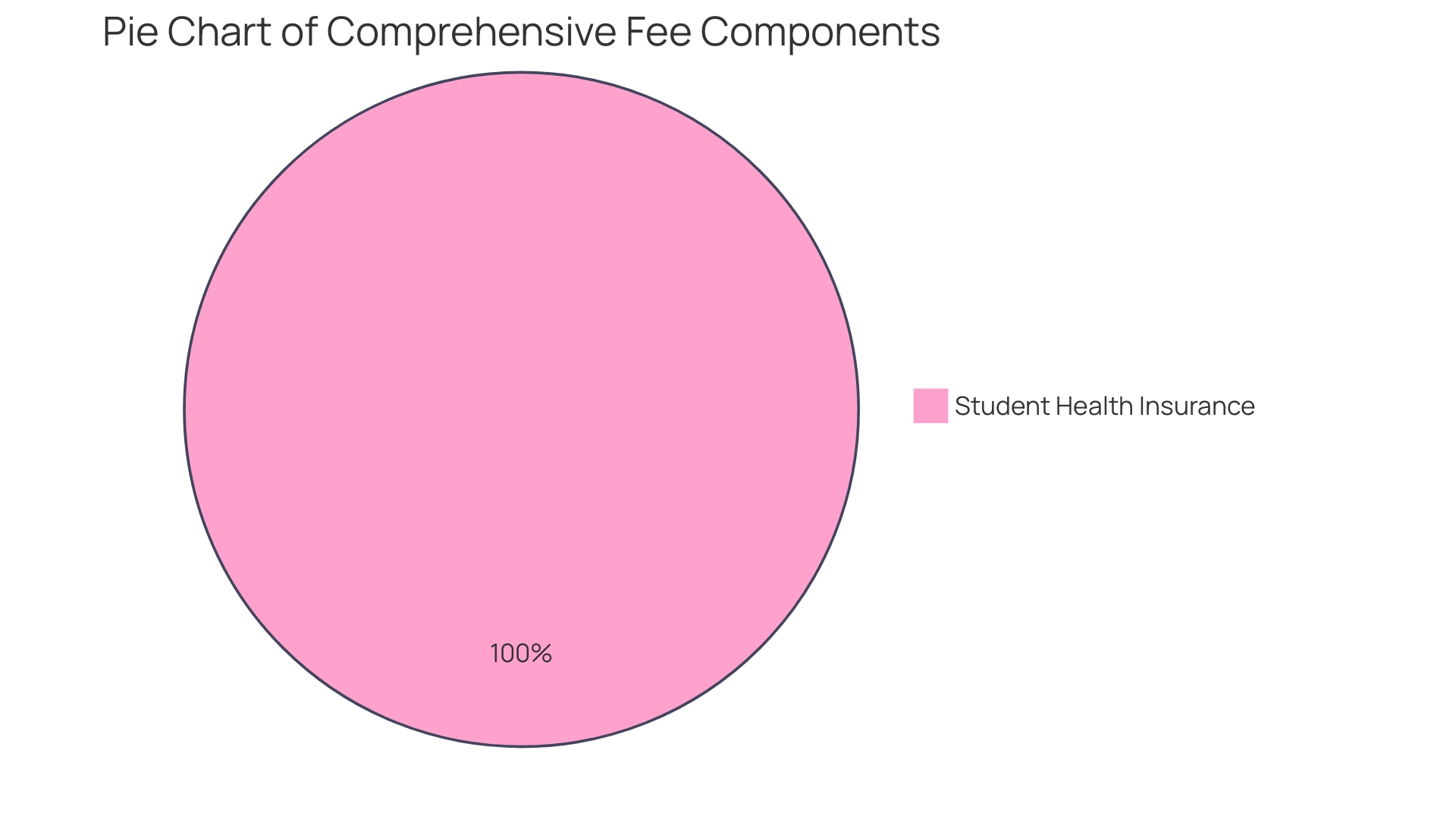
Step 6: Project Accounts Receivable and Payable
Crafting a robust cash flow strategy is paramount for a business's financial health. Start by analyzing your sales forecast and mapping out the expected cash inflows from accounts receivable. This includes considering the agreed-upon credit terms with your customers, average collection periods, and the speed at which you can convert sales into cash.
Concurrently, it's essential to schedule your cash outflows related to accounts payable, which hinge on your negotiation with suppliers regarding payment terms.
In the intricate dance of cash flow management, it's crucial to anticipate and prepare for the natural ups and downs in your industry. For instance, if your business operates in a cyclical industry, it's wise to maintain a buffer of cash reserves to tide over lean periods. Jack McCullough, president of the CFO Leadership Council, underscores the importance of meticulous planning for downturns in such sectors where the 'feast or famine' scenario is prevalent.
Moreover, a sound understanding of the distinction between cash flow and profit can serve as a beacon for financial decision-making. Profit may indicate the overall financial health of a business, but it is the management of cash flow—the lifeblood of your company—that ensures day-to-day operations run smoothly without hiccups.
To bolster your cash flow, reevaluating all expenditures and prioritizing them is a strategic move. Not all costs are equal, and some investments may yield better cash flow improvements than others. This process involves a careful examination of your financial situation with an eye on future goals, ensuring you're not cutting costs at the expense of growth potential.
Remember, the key is not just to survive but to thrive by employing strategic cash flow management practices that align with both your immediate operational needs and long-term financial objectives. These strategies help in maintaining a stable financial platform from which your business can grow, innovate, and capitalize on new opportunities as they arise.
Step 7: Incorporate Other Cash Inflows and Outflows
To effectively manage the ebbs and flows of corporate finances, incorporating additional cash inflows and outflows into financial assessments is crucial. This includes meticulous accounting for investments, loans, dividend receipts, interest income, and tax payments. The precision in capturing the timing and volume of these transactions is vital for a comprehensive financial analysis.
For instance, Citizens Financial Group, with its extensive assets and services, emphasizes the importance of robust financial tools and strategies. Mark Valentino, head of Business Banking, articulates the significance of cash flow forecasting, which not only consolidates financial operations but also boosts profitability, productivity, and cost-efficiency. Recognizing the nuances of cash flow ensures that businesses can operate smoothly, meet financial obligations, and potentially increase returns to investors.
Furthermore, the statement of cash flows, a key financial document, sheds light on a company's financial health by detailing cash movements. The main components include operating activities, reflecting core business operations, and adjustments for non-cash items. These insights are essential for businesses to prevent cash shortages and maintain operational viability.
As reiterated in various industry insights, cash flow management remains a cornerstone of business success. The ability to navigate the intricate cash movements within a company can be the deciding factor between thriving growth and business failure. By acknowledging these realities, businesses can implement strategies that ensure sustainability and competitive advantage.

Step 8: Review and Adjust
Cash flow forecasting is an essential tool for maintaining the financial health of your business. It enables you to predict the inflow and outflow of cash, ensuring that you have enough liquidity to meet your obligations. However, forecasts are not set in stone and must be continually revised to reflect the ever-changing business landscape.
When adjusting your forecasts, consider the effectiveness of past strategies in responding to market shifts and customer preferences, as well as the efficiency of your operations and supply chain processes.
To ensure your cash flow planning is accurate and adaptable, regularly analyze your financial documents, including income statements, balance sheets, and cash flow statements. This allows you to track your business's financial performance against your initial goals and make data-driven decisions. In addition, recent statistics highlight the importance of a high-quality cash flow statement for investors.
It helps them assess a company's potential to generate future net cash flows and meet financial obligations, which underscores the need for scrupulous management of cash flow reporting.
Furthermore, consider adopting innovative approaches to improve your forecasting accuracy. For example, some businesses have successfully implemented Monte Carlo Simulations to better predict their financial timeline and manage product release schedules. These simulations can account for various uncertainties and provide a range of possible outcomes, helping you make more informed decisions about future financial planning and resource allocation.
Remember, managing cash flow is not just about keeping your business afloat; it's about strategic growth and ensuring your business remains competitive and profitable over the long term. Therefore, it's crucial to continually reassess and adjust your financial strategies to stay ahead. By doing so, you can preemptively tackle potential cash shortages and position your business for success.
Benefits of Cash Flow Forecasting
Understanding and managing cash flow is a cornerstone of ensuring business vitality. For companies both large and small, the ability to forecast cash flow accurately not only illuminates the financial health of the enterprise but also supports strategic decision-making. A comprehensive view of cash movement, as detailed in a cash flow statement, is divided into operating activities, investing activities, and financing activities.
This breakdown is crucial for pinpointing where cash generation is strongest and where it may be lagging.
Operating activities are particularly telling, as they reflect the cash transactions related to the core business operations. This can include cash generated from sales and expenses tied to business activities, alongside adjustments for non-cash items like depreciation. A keen eye on operating activities can help businesses, such as eCommerce stores with their low startup costs and global reach, as well as consulting services with their potential for steady, ongoing client payments, to maintain liquidity and avoid cash shortages that could be catastrophic.
Cash flow forecasting not only aids in preventing the dire consequences of running out of cash but also equips businesses with the information needed to pursue opportunities for growth. By understanding the ebbs and flows of money, and the unique differences between cash flow and profit, businesses can create strategies to maintain a healthy balance and ensure long-term sustainability. The movement of cash in and out of a business is the lifeline that keeps it operational, and mastering this aspect is often what separates thriving businesses from those that fail.
Therefore, cash flow forecasting is not only a tool for financial management but also a strategic asset that can inform investment decisions, highlight potential risks, and support the pursuit of new market opportunities. It is an indispensable practice for businesses aiming for resilience and growth in the ever-evolving commercial landscape.
Improved Financial Planning
Understanding the dynamics of cash flow is critical for businesses to make informed strategic decisions. Precise cash flow projections aid in crafting accurate financial plans and optimize resource allocation. For instance, Sirius Technologies utilized a platform to manage Cloud Development Environments, improving their productivity and financial services quality.
This transition not only streamlined their operations but also enhanced client collaboration and intellectual property management. Additionally, awareness of the differences between cash flow and profit is essential for maintaining business health. A cash flow statement, with its breakdown into operating activities and other components, offers a transparent view of a company's financial status, enabling better decision-making.
Moreover, addressing the diverse financial needs of the workforce, such as offering daily access to payroll funds, can significantly impact employee satisfaction and, in turn, the bottom line. Embracing data-driven decision-making further empowers organizations to stay competitive. As per S&P Global, a significant portion of businesses now rely heavily on data to guide their choices, underscoring the value of financial analytics tools for objective and evidence-based decisions.
Enhanced Cash Management
The precision of cash flow forecasting is a pivotal aspect of financial management, particularly for businesses keen on maintaining optimal cash reserves. Accurately predicting periods of cash abundance or scarcity allows companies to take preemptive action, ensuring efficient allocation of financial resources. For instance, Citizens Financial Group, a venerable institution with substantial assets, underscores the importance of cash flow forecasting for its clients, particularly small and mid-size businesses.
By offering state-of-the-art digital tools, Citizens assists these enterprises in achieving financial consolidation and heightened performance, as expressed by Mark Valentino from Citizens.
Valentino's insight is supported by a Citizens’ survey indicating that businesses employing consolidated cash flow tools experience tangible benefits: a 44% increase in profitability, a 43% boost in productivity, and a 42% reduction in costs. These outcomes emphasize the strategic value of forecasting in steering businesses towards financial optimization.
Moreover, the significance of managing cash flow is amplified in cyclical industries, where revenue is closely tied to economic fluctuations. Jack McCullough of the CFO Leadership Council highlights the necessity for careful planning in these sectors to weather economic downturns. With a comprehensive cash flow statement, businesses get a transparent view of their financial activities, including operations, lending, and investments, which is crucial for informed decision-making.
As business ventures like eCommerce stores and consulting services seek sustainable profits, mastering cash flow management becomes indispensable. It's the understanding of money's movement within a business that secures its longevity. Preventing cash shortages is crucial; a steady cash inflow not only sustains but also propels a business forward, safeguarding it from the risks associated with cash deficits.
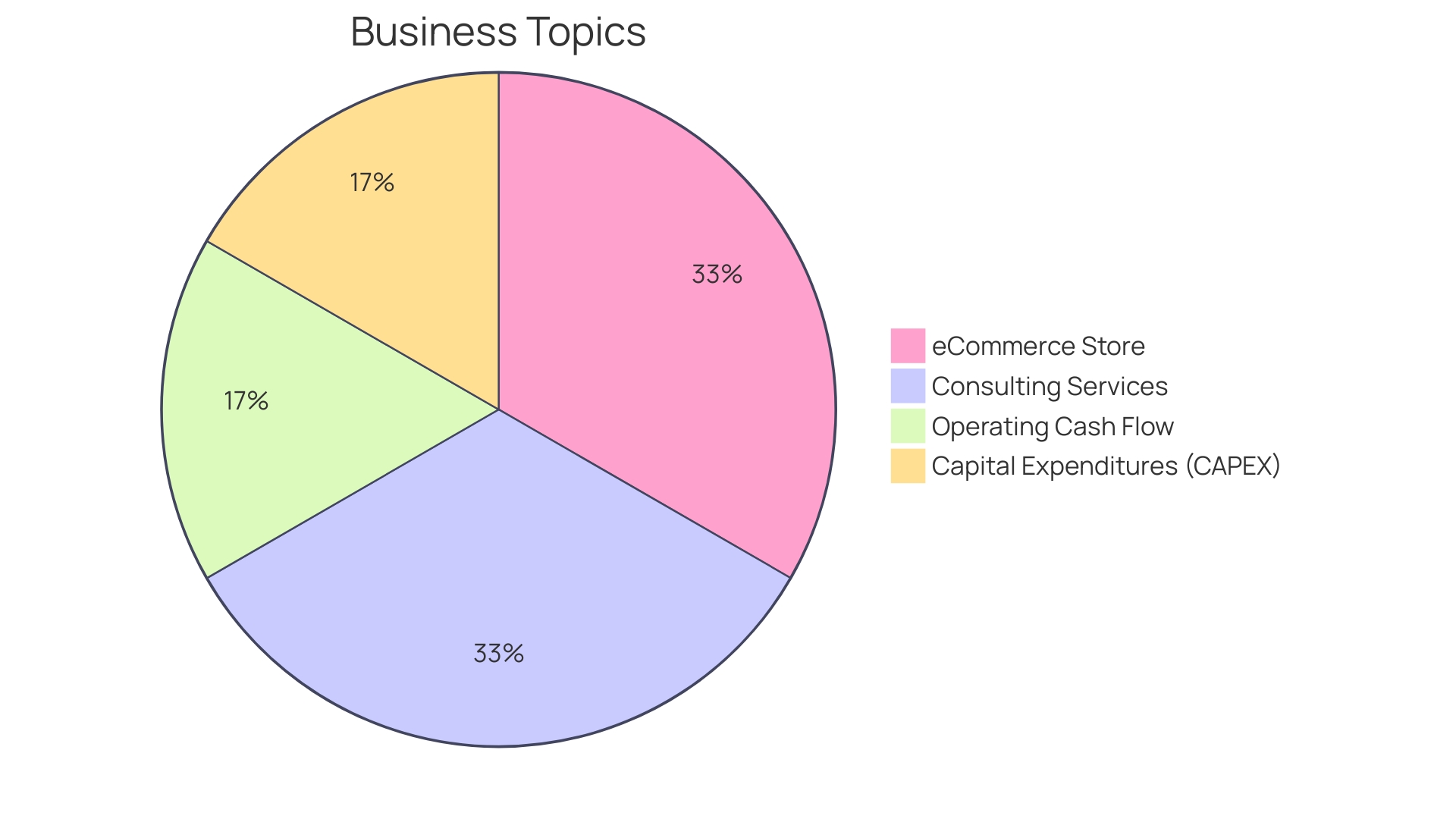
Risk Mitigation
Mastering cash flow is essential for any business aiming to secure long-term profitability and sustainability. This financial strategy goes beyond just monitoring the ebbs and flows of cash; it is about anticipating future financial needs and ensuring a business can meet its obligations at all times. A strong cash flow management plan can mean the difference between a thriving business and one that struggles to survive due to cash shortages.
For example, Citizens Financial Group, Inc., with its substantial assets and broad range of banking services, understands the importance of maintaining a healthy cash balance to support both day-to-day operations and strategic growth initiatives. Similarly, businesses must be vigilant in reviewing their financial statements, including the cash flow statement, income statement, and balance sheet, to gain a comprehensive understanding of their financial health.
Even profitable companies can face cash flow challenges if they fail to manage their funds wisely. Cash flow is not merely a measure of profitability; it represents the liquidity available to cover expenses, invest in growth opportunities, and ensure smooth operational continuity. Dr. Sharon H. Porter emphasizes the importance of knowing your numbers and having a smart plan for fund allocation.
In the broader perspective of corporate finance, value maximization should be the ultimate goal, guiding investment decisions, financing strategies, and shareholder returns. While profit maximization is often the focus, true value maximization can lead to more informed decisions that support a company's growth and potential, even if it means accepting lower profits or enduring losses in the short term.
In conclusion, effective cash flow management requires a proactive approach that includes understanding financial intricacies, reviewing financial statements diligently, and aligning operational strategies with the overarching goal of maximizing value.

Better Decision-Making
Mastering cash flow is a pivotal element for businesses aiming to secure financial health and steer towards sustainable growth. Crafting precise cash flow projections empowers companies to navigate investment opportunities, expansion endeavors, and financial obligations with confidence. These forecasts act as the blueprint for evaluating the viability and associated risks of potential ventures, ensuring that resources are allocated strategically to foster returns and business expansion.
The operating activities within a cash flow statement, reflecting the cash transactions linked to the business's core operations, are particularly critical. This section accounts for cash derived from sales, operational expenses, and adjustments for non-cash items such as depreciation, as well as variations in working capital accounts like accounts receivable and payables. For large corporations such as Citizens Financial Group, with extensive assets and operations, robust cash flow management and astute financial planning are instrumental in sustaining their expansive array of services ranging from retail banking to complex financial solutions.
Dr. Sharon H. Porter emphasizes the significance of comprehensive financial statement analysis, including cash flow statements, to grasp a company’s revenue, expenses, profitability, and debt, which are key indicators of future success. Similarly, maintaining a strategic approach to fund allocation, including judicious investment decisions that yield returns, is essential for leaders to avert financial pitfalls.
Understanding the distinction between cash flow and profit is also crucial for operating a profitable business. While cash flow represents the actual movement of money, profit is an accounting construct, and both require careful monitoring to ensure a business's longevity and prosperity. As such, a sound cash flow strategy ensures that a business can cover its expenses, invest strategically, and grow, thereby avoiding the disastrous consequences that can arise from cash shortages.
Best Practices for Effective Cash Flow Forecasting
To enhance the precision and trustworthiness of cash flow projections, it's essential to draw on proven methodologies. By compiling historical data, businesses can construct a forecast rooted in actual performance. This should include a review of at least three years of sales records, expense reports, and financial statements to grasp seasonal trends, long-term shifts, and irregular events.
If a business is relatively new, the available data should still be leveraged to form a foundation for financial predictions.
Mark Valentino of Citizens Financial Group underscores the importance of empowering businesses with digital tools for financial planning. According to a Citizens' survey, small to mid-sized businesses that have streamlined their cash flow tools have seen increased profitability by 44%, productivity by 43%, and cost reductions by 42%. These tools not only consolidate financial data but also enhance financial performance, allowing business owners to focus on their passions.
It's also crucial to distinguish between cash flow and profit, as both are vital yet distinct aspects of business health. Cash flow tracks the actual movement of money in and out of a company, vital for meeting day-to-day obligations. Effective cash flow management can prevent the dire consequences of cash shortages, which can cripple otherwise successful businesses.
This strategic financial balance is the lifeline that enables businesses to cover expenses, invest strategically, and grow sustainably.
Lastly, industry-specific considerations can't be overlooked. As Jack McCullough of the CFO Leadership Council notes, cyclical industries, such as construction or oil and gas, must meticulously plan for economic downturns and maintain adequate cash reserves. This is in contrast to non cyclical industries, which typically experience more consistent revenue flows.
For businesses, adopting these best practices can lead to a robust cash flow forecast, serving as a cornerstone for financial strategy and long-term prosperity.
Regularly Update Your Forecast
To secure the financial health of a business, it's crucial to keep cash flow forecasts in tune with the dynamic nature of the market, operational shifts, and any financial changes. A robust cash flow strategy is the lifeblood of a business, allowing it to navigate through the complexities of growth and operational demands. Mature companies may find their value and profit objectives aligning, yet for most, particularly those in high-growth sectors like technology and green energy, the focus on scaling can overshadow the importance of sustainable business models and profitability.
Understanding the difference between cash flow and profit is fundamental; while profit reflects the financial gain, cash flow is the actual liquidity moving in and out of the business. This liquidity is essential for day-to-day operations and long-term strategic investments. Leaders should avoid the common pitfall of neglecting comprehensive financial reviews; as Dr. Sharon H. Porter emphasizes, 'Know your numbers!'
This keen awareness can be the difference between thriving and merely surviving, especially in a landscape where unicorns—start-ups valued over $1 billion—are more common, but few are generating sufficient cash from operations to sustain themselves without ongoing capital injections. In this context, continually revising cash flow projections isn't just good practice—it's a critical discipline for steering a company towards enduring success and value maximization.
Monitor and Analyze Variances
To optimize financial health and drive strategic growth, it's crucial to track and manage cash flow meticulously. A robust approach involves routinely contrasting forecasted cash flow with actual numbers, pinpointing variances that could indicate necessary refinements in your forecasting techniques. This vigilant monitoring is not just about correcting errors but is a proactive measure to ensure financial agility and informed decision-making.
Citizens Financial Group, Inc., with substantial assets and a broad range of banking services, underscores the importance of tailored financial solutions. Their dedication to understanding customer needs and providing strategic advice is a testament to the value of personalized cash flow management. Similarly, Monday.com's efficiency in becoming free cash flow positive showcases the significance of growth coupled with financial sustainability.
Cash flow, the lifeblood of a business, is more than mere numbers; it represents the company's ability to sustain operations, invest strategically, and expand. For instance, Monte Carlo simulations are now used to predict product completion and manage release schedules, highlighting the evolution of forecasting methods. This advancement helps businesses like those with critical on-premise products to plan effectively, even when shipments are involved.
In the business landscape, the stark difference between cash flow and profit must be acknowledged. While profit is the surplus after expenses, cash flow is the actual movement of money in and out of the business, crucial for survival. It is essential to prevent cash shortages, as they can lead to the downfall of even the most outwardly successful businesses.
To this end, value maximization is the ultimate goal, driving investment choices, financial strategies, and shareholder returns. The pursuit of value over profit is particularly relevant for growth-oriented companies willing to sacrifice short-term gains for long-term prospects. This strategic focus on value can lead to more efficient growth, as seen in the case of Monday.com, which has generated significant free cash flow and shareholder value.
Collaborate with Key Stakeholders
To enhance the precision and utility of cash flow projections, it's crucial to tap into the collective wisdom and experience of diverse organizational players. By bringing together department leaders, financial personnel, and top executives, the forecasting process benefits from a range of perspectives that reflect the operational intricacies and strategic directions of the business. Such collaboration not only enriches the forecast with in-depth insights but also fosters a shared commitment to the financial well-being of the enterprise, aligning efforts towards sustainable profitability.
Citizens Financial Group's approach, which entails a comprehensive understanding of customer needs and tailored solutions, echoes the importance of collaborative input in financial planning. This synergy is essential for businesses to navigate the complexities of cash flow management, a critical determinant of a company's vitality and its ability to meet obligations and seize growth opportunities. Moreover, the integration of financial analytics tools, as indicated by S&P Global's survey, underscores the trend towards data-driven decision-making in finance, a practice that reduces bias and equips leaders with actionable insights.
However, the challenges of data security and the scarcity of skilled professionals, as highlighted by industry reports, present hurdles in adopting sophisticated financial tools. These challenges necessitate a strategic approach to cash flow forecasting that leverages both human expertise and analytical capabilities to steer clear of operational disruptions and ensure regulatory compliance. As the lifeblood of any business, maintaining a steady cash flow is indispensable for operational success, strategic investments, and ultimately, the company's longevity and prosperity.
Consider Scenario Analysis
Conducting scenario analysis is a vital tool for understanding how different factors might affect your business's cash flow. Particularly, integrating Monte Carlo Simulations into your analysis can offer a nuanced view of potential outcomes. This method, which has been successfully applied in settings where products are part of critical infrastructure, helps in planning releases and forecasting feature completion dates.
It can be equally effective in financial planning to estimate the probability of different cash flow scenarios and prepare accordingly.
Consider the effects of climate change, which present both physical and transition risks to businesses. Scenario analysis here goes beyond assessing the direct impacts of severe weather events; it also involves deeper questions about how changing policies and consumer behaviors might affect your business model and financial stability. For example, the transition to greener economies might introduce new regulatory risks or opportunities, which could significantly affect cash flow.
Approaching scenario analysis with a clear understanding of cash flow's importance is crucial. As cash flow is the lifeblood of a business, distinguishing between cash flow and profit is essential for effective management. Through scenario analysis, you can anticipate potential cash shortages and create strategies to avoid them, ensuring that your business remains solvent and competitive in the face of uncertainty.
The need for such forward-looking analysis is underscored by historical examples showing that the adoption of new technologies and practices can be slow, affecting productivity gains. By examining various scenarios, including the rate of business adoption and adaptability, companies can better prepare for the future, making scenario analysis an indispensable tool in the financial toolkit.
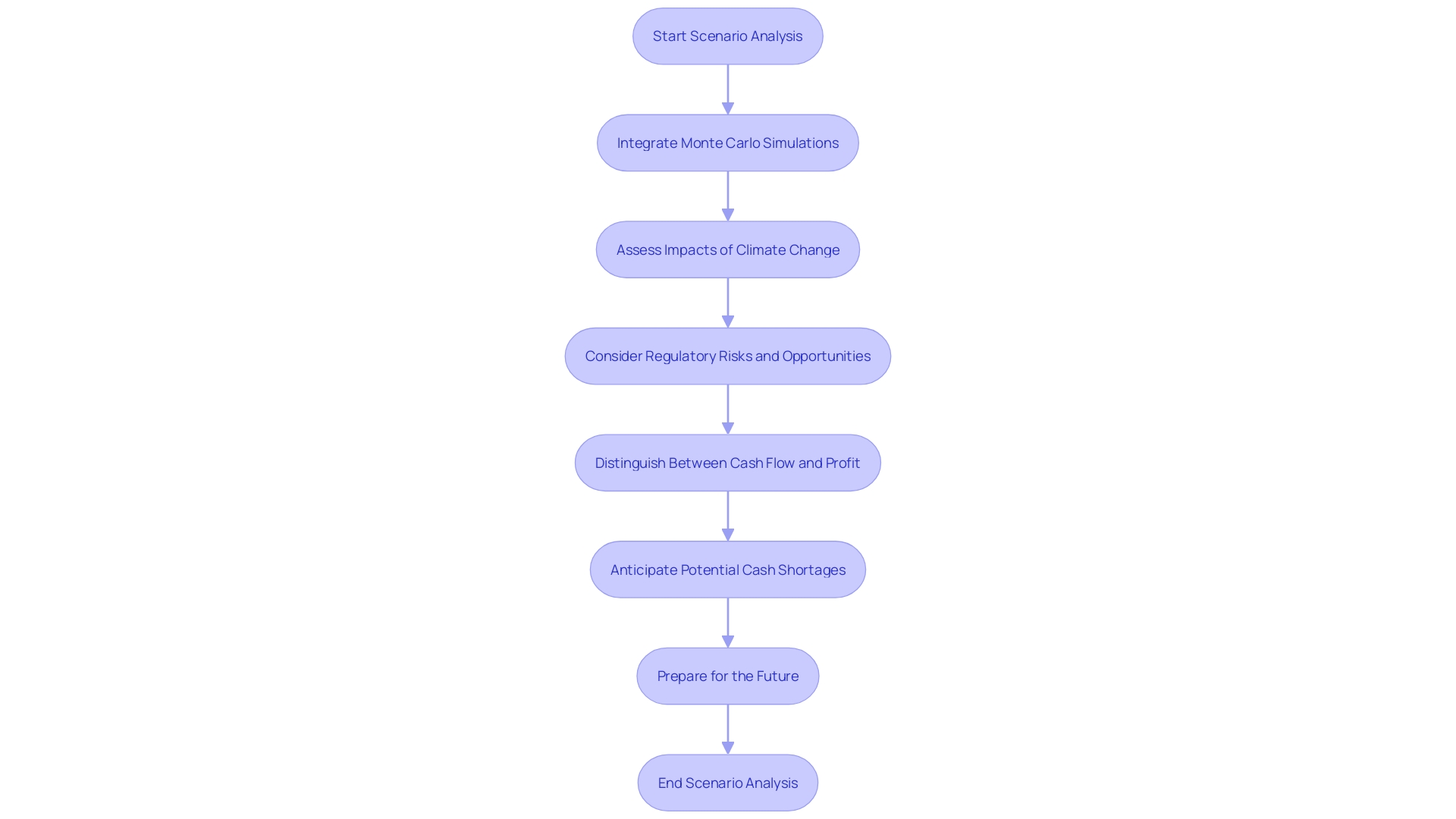
Automate Your Cash Flow Forecasting
Leveraging cutting-edge cash flow forecasting software could be transformative for businesses intent on optimizing financial operations. This technology not only simplifies the collection and analysis of financial data but also enhances the precision of reports. By integrating forecasting and budgeting—two fundamental yet distinct aspects of finance—organizations can anticipate future performance and set concrete financial objectives.
The forecasting aspect involves projecting future business scenarios based on historical and current financial data, while budgeting defines the monetary targets for a specified timeframe. Using forecasting as a foundation, companies can establish their budgets and continually track their financial trajectory. The utilization of such software furnishes businesses with a robust framework for financial planning, enabling them to sidestep potential cash shortages and maintain a robust fiscal posture.
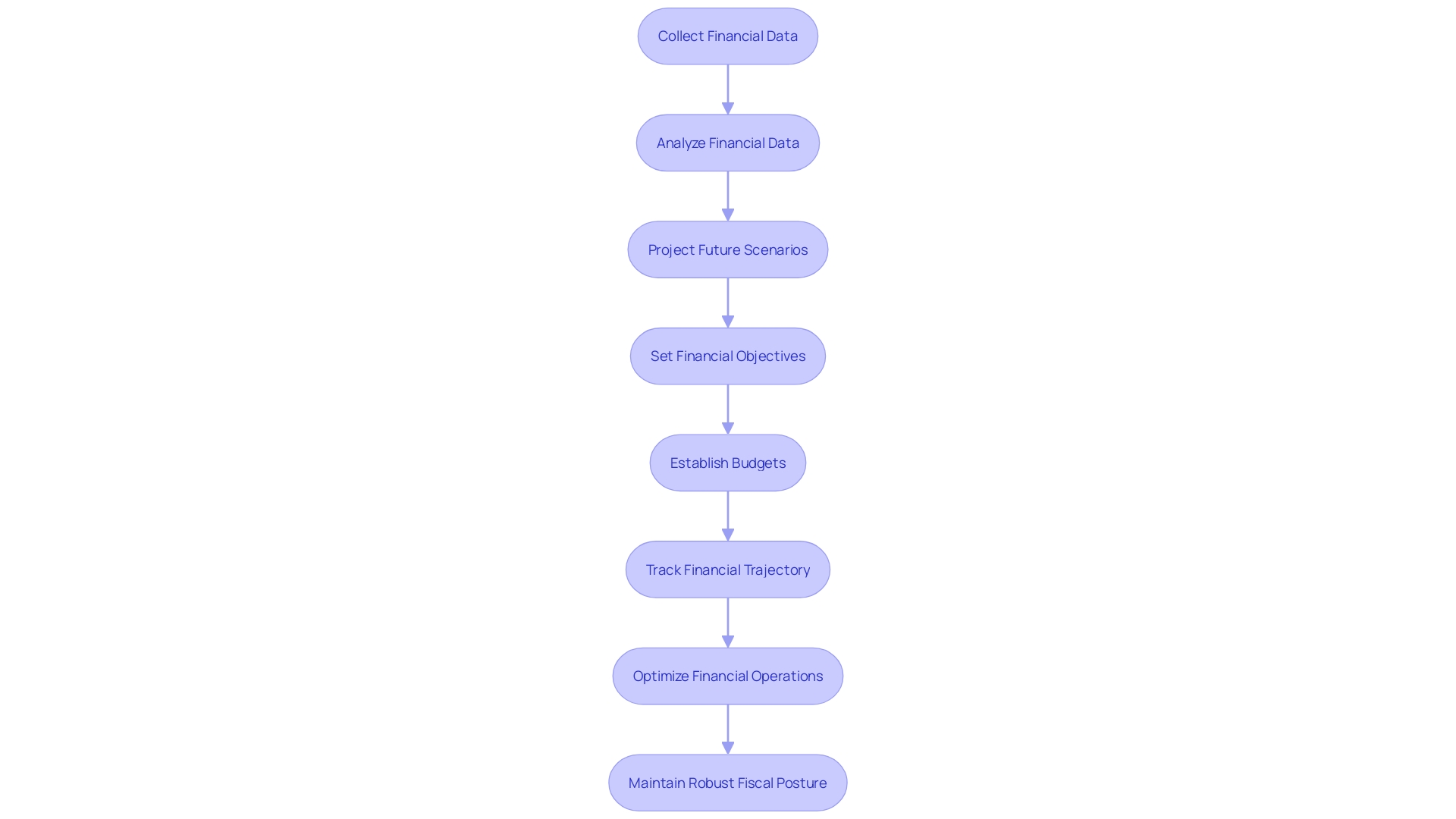
Conclusion
In conclusion, mastering cash flow forecasting is crucial for businesses to ensure financial stability, make informed decisions, and navigate the complexities of today's dynamic financial landscape. By accurately predicting cash inflows and outflows, companies can effectively manage resources, handle working capital, and avoid liquidity pitfalls. Cash flow represents the actual movement of money in and out of the business, critical for covering expenses, strategic investments, and funding growth.
Crafting an effective cash flow forecasting model involves understanding historical data, accurately forecasting sales and expenses, monitoring accounts receivable and payable, and incorporating other cash inflows and outflows. By following best practices and leveraging advanced techniques, businesses can optimize their cash flow management, ensure financial health, and position themselves for long-term success.
Cash flow forecasting offers benefits such as improved financial planning, enhanced cash management, risk mitigation, and better decision-making. It provides businesses with a comprehensive view of their financial health, enabling them to make informed investment decisions, identify potential risks, and pursue new market opportunities. It is a strategic asset that helps businesses maintain liquidity, cover expenses, and fuel growth.
To effectively manage cash flow, businesses should regularly review and adjust their forecasts, collaborate with stakeholders, and consider scenario analysis. By analyzing financial documents, tracking performance, and adopting innovative approaches, businesses can enhance forecasting accuracy and adapt to the ever-changing business landscape.
In today's competitive business environment, mastering cash flow forecasting is essential. It empowers businesses to ensure financial stability, make informed decisions, and navigate the complexities of the financial landscape. By following best practices and leveraging advanced techniques, businesses can optimize their cash flow management and position themselves for sustained profitability and long-term success.




